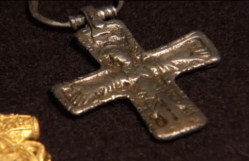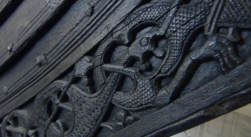Carolingians and Vikings
Anglo-Saxons
The Dark Ages: Men of the North

We are going to be looking at the Carolingians. Dark Age expansionists from France, whose huge empire gobbled up most of modern Europe but who made art of exquisite finesse and richness. Also the Vikings, who, despite the terrible reputation for raping and pillaging, were actually exceptionally inventive craftsman. The extreme delicacy of dark age Viking art is an unexpected pleasure.
Then up here in the north of England, we’ll be celebrating the dark age nation whose artistic handiwork was admired across the whole of Europe. I’m thinking, of course, of the Anglo-Saxons – so skilled, so hard-working, so ingenious.
Speaking of hard work, one of the things we are going to be doing in this programme is following the creation of an Anglo-Saxon jewel from start to finish. Later on, I’ll introduce you properly to Shaun Greenhalgh here. For now, all that really matters is that he’s going to be making something exquisite – a silver disc brooch in the Anglo-Saxon manner.
First, we need to confront the north’s most notorious barbarians. We’ve tackled some terrifying warrior nations in this series – the Huns, the Vandals, the Goths – but when it comes to bellicosity, no one has quite as fearsome a reputation as the Vikings.
You know, people get so much wrong about the Vikings. They didn’t wear these ridiculous helmets, for a start. These were invented in the 19th century by a stage designer working on a Wagner opera. He had to make one of the singing Vikings look particularly evil so he stuck the devil’s horns on a helmet and the Vikings have been lumbered with these helmets ever since.
This is what their helmets really look like. The only surviving Viking helmet in the National Museum in Oslo. The Vikings were particularly interesting because, while all the other Germanic tribes headed south and became thoroughly Italianate, the Vikings stayed in the harsh and windy north where they clung to the old ways. So, they were a barbarian nation of a pure and exciting type.
The Vikings were a living link to an older and deeper European past. There were forces at work in them that civilisation hadn’t dimmed. And that’s what’s so exciting about them.
In fact, most of the time they were simple farmers, tending the land, keeping livestock, growing what they could. But in the lands of the Vikings, you can’t go very far without encountering water. And this constant presence of the sea had turned them into superb sailors. Exactly where they reached is still fiercely debated but they certainly got to Greenland and then to Newfoundland. The Vikings discovered America a long, long time before Columbus. So, boatmanship was one of their great achievements and another of their great achievements was art.
In the great years of Viking expansion, roughly 800 A.D. to roughly 1100 A.D., the Vikings put almost as much energy into making their own art as they did into stealing other people’s.
This trefoil Viking brooch was modelled on the buckles used by Roman soldiers on their sword belts. The Vikings adapted it and turned it into a brooch for ladies. Much of what they made is so intricate and fine. It’s difficult to see. So, to make it absolutely clear what adventurous creatives they were, I’ve brought you to Oslo, to one of the great Viking museums where where I wanted to show you this whopping great nautical masterpiece.
Knut Rom visits Professor Gabriel Gustafson
On the 8th August 1903, a Norwegian farmer called Knut Rom knocked on the door of Professor Gabriel Gustafson of the Museum of Antiquities here in Oslo. While digging on his farm, said Knut Rom, he had come across a buried ship and he thought it might be Viking.
Two days later, Professor Gustafson arrived at the farm and confirmed the discovery of this thing – the Oseberg ship. It’s made entirely of oak. Over 60 feet long, 15 feet wide and decorated at both ends with these boisterous Viking carvings.
Inside the ship were two dead bodies – an older woman who may have been a queen and a younger woman, probably her slave who was buried with her. There were also 14 horses, three dogs and an ox, all sacrificed together and buried with their master.
In the stern of the boat was a four-wheeled cart, the first such Viking cart ever discovered. But no one seemed too sure what the weather was going to be like in heaven because there were also four sledges.

But it’s the carving of these boats and carts and sledges that makes this particular Viking find so exciting. Look at the elegant line of this ship, how it ends so gracefully up there with the curved head of the snake. At either end, above the waterline where they can be seen, and these busy expanses of carving, so active and lively. Scores of twisting bodies, clutching hands, staring eyes, sniffing snouts, all jumbled together excitedly. A gymnasium of animal acrobats tying themselves into knots.
You have to get your eye in with Viking carvings otherwise they can frighten you with all this amazing complication. It’s all based on animal shapes all interwoven and overlapping. So, that, for example, is one animal. there’s the head and there’s the tale. And this figure eight shape here, that’s the whole of its body. And that’s biting the tale of this animal here. And that animal is biting the tale of that animal and so on.
So, imagine the 3-D vision you need to carve this, the steady hand, the computer brain. So, if anyone ever says to you, “the Vikings were barbarous”, grab them by the ear and tug them here to Oslo.
